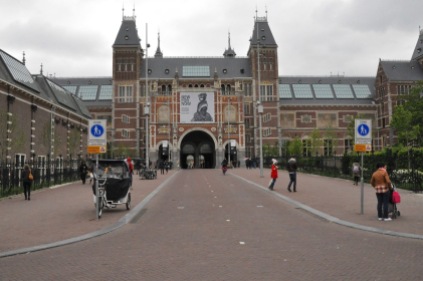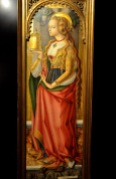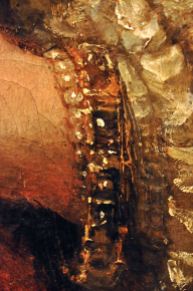The Rijksmuseum is the largest art museum in Amsterdam and one of the richest in the world, with a collection exceeding a million pieces covering the years 1200 – 2000; it is not something to see in a single day! Or for that matter, in a single post! I hope you’re ready to look at a lot of paintings. Your reward for this slog? They’re amazing paintings. You’ll see.
The Rijksmuseum was founded in 1800 at the Hague, and moved by the King (Napoleon’s brother) to Amsterdam in 1808. The current Neogothic building opened in 1885, and as shown below, it’s impressive. In that last picture, I can just see the horses and buggies of
yesteryear delivering their well-dressed owners!
The museum is surrounded by fountains and gardens and statues, as shown below, but what intrigued me most was the artwork incorporated into the building itself, primarily
tiles of historical events, shown below.
Very classy! As is the interior. Below is a quick look at the formal entrance hall, with paintings that mostly depict scenes from Dutch history. Those stained glass windows
of the entrance hall are also pretty cool.
Now, the main reason for visiting this museum! The Rijksmuseum has the best collection of Dutch Masters paintings in the world! The Dutch Masters – such as Rembrandt, Vermeer, & Frans Hals – painted during the Dutch Golden Age, from about 1600 to the end of that century. I am in awe of these paintings for two major reasons; they interestingly depict life – often ordinary life – from a very different time; and they display incredible, perhaps unmatched technique with their 50 shades of black, their depiction of starched lace that makes your eyes feel scratchy, their painting of transparent glass, their capture of light’s reflections, and the ethereal quality of the light in which they bathe their subjects. The combination is simply breathtaking. HOWEVER, the museum of course covers a lot more than just those years, so let’s start with a quick look at some earlier art from the 1400’s.
Medieval art was chiefly related to Christianity, made (and paid for) to serve needs for worship and veneration – and needed to fill the many spacious Gothic cathedrals being built. Art from the 1400’s were done in a style called “International Gothic” reflecting its widespread distribution and marking the end of the medieval period, to be followed by the Renaissance. The wood carvings and statues from this time are impressive, as shown
here, as are the paintings, shown below. That first painting was done by a favorite of ours, Fra Angelico, a monk who – somewhat scandalously – often painted Madonna with
the face of his lover. The other marvelous painting shown above is by Carlo Crivelli, done near the end of the International Gothic style.
 OK, off to the good stuff! Let’s start with one of the highlights of the museum – one of the most famous Dutch Golden Age paintings from the greatest portrait artist of the time, Rembrandt van Rijn’s Night Watch, 1642. It’s sufficiently important to have its own room, and it’s placed just so; the painting is at the visual center at the end of the hall in this picture. The Night Watch is a group portrait of the city’s civic guard getting ready to move out. Until this painting, group portraits showed people sitting or standing stiffly. Not here! The picture is an action shot; motion is everywhere. Furthermore, details of the
OK, off to the good stuff! Let’s start with one of the highlights of the museum – one of the most famous Dutch Golden Age paintings from the greatest portrait artist of the time, Rembrandt van Rijn’s Night Watch, 1642. It’s sufficiently important to have its own room, and it’s placed just so; the painting is at the visual center at the end of the hall in this picture. The Night Watch is a group portrait of the city’s civic guard getting ready to move out. Until this painting, group portraits showed people sitting or standing stiffly. Not here! The picture is an action shot; motion is everywhere. Furthermore, details of the
guards’ attire are stunning. Look at the uniform of the dude in the light outfit! He’s depicted in such exquisite detail, with a strong 3-D component, that you would hardly be surprised if he walked out of the painting. And, of course, there’s a selfie that Rembrandt incorporated at the left edge. Cute!
Below is another civic guard painting, Militia Company of District VIII under the Command of Captain Roelof Bicker, 1643, this one by Bartholomeus van der Helst, one of
the leading portrait painters of the Dutch Golden Age. Like Rembrandt’s painting, it’s huge, filling an entire wall (and including a selfie at the far left, as well). And like Rembrandt’s painting, it’s gorgeous.
There are soooooooooooo many Rembrandts here! The good news is that it’s not possible to be bored by them. Here’s a sampling, starting with the young Rembrandt. This first
one is Tobit and Anna with the Kid, 1626. The story is that Tobit is blind, condemning him (and wife Anna) to grinding poverty. When Anna comes home with a goat, a reward for hard work, Tobit thinks she stole it and prays for his quick death.
The first painting below is Rembrandt’s Musical Company, 1626, followed by his Self-
portrait, 1628. For Self-portrait, even at just 22 years of age he’s experimenting, with the light interestingly just glancing along his cheek, the rest of his face veiled in shadow. The curls of his hair were made by scratching the wet canvas with the butt end of his brush.
This next Rembrandt is An Old Woman reading, Probably the Prophetess Hannah, 1631
(according to the Gospel of Luke, Hannah was an elderly lady who worshiped God day and night). It’s amazing. Look at that wrinkled hand!
Rembrandt painted only a few landscapes – here’s one of them, Landscape with a Stone
Bridge, 1638. It’s pretty cool, with the dramatic sunlight contrasting with the approaching storm.
We’ll finish this Rembrandt section with some of his later paintings. We’ll call these next two paintings ‘family portraits’; the first is Rembrandt’s Son Titus in a Monk’s Habit, from 1660, and Self-portrait as the Apostle Paul from ’61 (it was common during this time to
portray people as historical personages). Another later painting is historical, The Conspiracy of the Batavians under Claudius Civilis, 1661, depicting the one-eyed Batavian
chieftain entering a treaty to overthrow the Romans (69 AD). The picture below is The Wardens of the Amsterdam Drapers’ Guild, Known as ‘The Syndics’, 1662. The syndics inspected the quality of dyed cloth, and here Rembrandt enlivened the scene by
portraying them looking up from their work as though disturbed by our arrival, a clever artistic device attesting to Rembrandt’s creativity even in his later works.
Our last Rembrandt is Isaac and Rebecca, Known as ‘The Jewish Bride’, 1665 . Note how this painting glitters, helped by the use of a palette knife and by painting reflections off the jewelry.
Leaving Rembrandt (alas!), below is a quick look at more Dutch landscapes. The first painting is River Landscape with Ferry by Salomon van Ruysdael, 1649. van Ruysdael
was famous for his pictures of the flat, watery Dutch landscape; here the small ferry contains 4 horses, 5 dogs, 2 cows and 11 people – yikes! Must be rush hour, as the other boats are fully loaded as well. The two paintings to the right are The Entrance to the Woods by Philips Koninck, 1665 and A Watermill by Meindert Hobbema, 1664. Hobbema studied under Jacob Isaacksz van Ruisdael, the pre-eminent landscape painter of the Dutch Golden Age, represented by the underlying two pictures, Landscape with Waterfall, 1668.
We’ll move on to Jan Havicksz Steen, known for his paintings of daily life – often involving a tavern (his parents owned a tavern, and at times he himself owned a brewery and a tavern); he’s also known for his sense of humor and psychological insights. The paintings are a delight!! His scenes often depict lusty life that approaches chaos, so much so that a Dutch proverb, “a Jan Steen household”, meant a chaotic surrounding. So let’s see some of these paintings! The first is The Merry Family, 1668, depicting a family making LOTS of noise – and also drinking and smoking. There’s a moral – the note hanging from
the mantel reads “As the old sing, so shall the young twitter”, suggesting less than ideal parenting (and presaging today’s internet?). The next is The Drunken Couple, 1655. After a night of revelry, the two individuals are so drunk they don’t realize they’re being robbed. The owl print above them contains the moral; considered a stupid bird in the 1600’s, the owl can’t see by day (even with the help of a candle). The following picture is The Feast of St Nicholas, 1665, which captures the elements of this holiday; the little girl has a bucket of treats, while the naughty boy gets a bundle of twigs in his shoe.
Continuing with Steen, the first picture below is Interior with a Woman Feeding a Parrot, Known as ‘The Parrot Cage’, 1660. The next painting is The Sick Woman, 1663. Is the
weak young woman pregnant? To test this, the old-fashion-attired doctor has put a strip of the woman’s clothing in a brazier to smoulder, the smell revealing her status; and the discredited technique identifying him as a quack. The last painting is Adolf and Catharina Croeser, Known as ‘The Burgomaster of Delft and his Daughter’, 1655. This is a portrait of a wealthy grain merchant sitting I think unattractively outside his house, where a poor woman and child beg him for alms. A rather strange portrait! Interestingly, 2 years later Mr. Croeser helped Steen deal with serious debt.
There’s a lot more of the Rijksmuseum to see, so I’ll have to do another post – or two? I’ll close this one with two popular painters from the later Dutch Golden Age, Johannes Vermeer and Pieter de Hooch. Who is Pieter de Hooch, you ask? Both painters specialized in interior scenes of domestic middle-class life, both had a sophisticated treatment of light, and both were keen observers of life’s everyday details. Vermeer was only modestly successful, dying in debt and historically ignored. Rediscovered in the 1800’s, he is now acknowledged as one of the greatest Dutch Golden Age painters. de Hooch, on the other hand, was more successful at the time, painting more and painting for wealthier patrons. Both had slightly different strengths, but Vermeer had the better technique. Let’s see them, starting with de Hooch. The first painting is Woman with a Child in a Pantry, 1656. de Hooch effectively creates interior space via doorways
and windows. The other painting is A Mother Delousing her Child’s Hair, Known as ‘A Mother’s Duty’, 1658, and uses the same technique to create depth.
The first Vermeer painting below, View of Houses in Delft, Known as ‘The Little Street’, 1658, is not your typical Vermeer subject; although the two figures doing chores in this painting are perfectly framed by doors, as if by actual picture frames, the subject is
clearly the carefully rendered detail of the old buildings. However, the next painting, The Love Letter, 1669, certainly is typical Vermeer with its domestic scene (in spite of its unusual vantage point). In this picture, the seascape on the wall behind the two ladies alludes to the letter’s content – in the 1600’s, the sea was often compared to love, and the lover to a ship. The last picture below, Vermeer’s The Milkmaid, 1660, is almost photographic, with glistening light on the crusty bread (and the milkmaid’s forehead).
The light gradations and the primary colors are treated with a virtuoso hand. Bravo.
The next post continues our Rijksmuseum tour with Old Master paintings. You’ll love them!





































































































